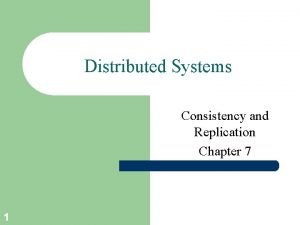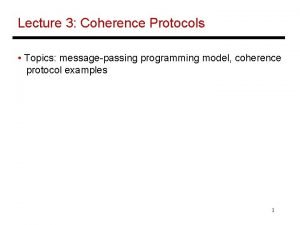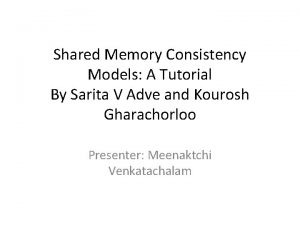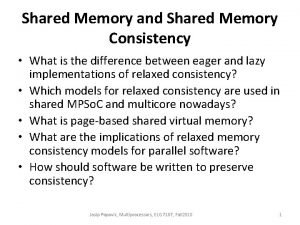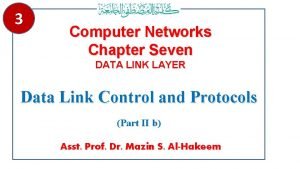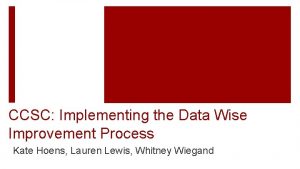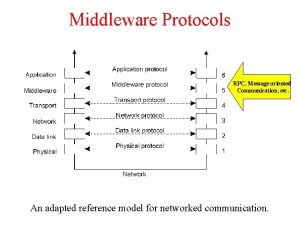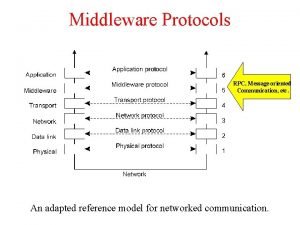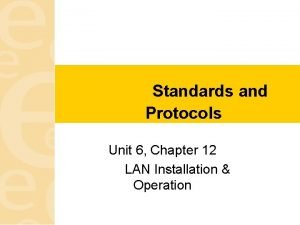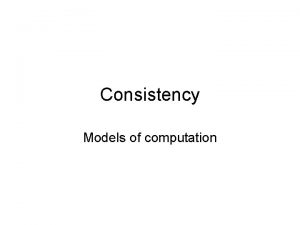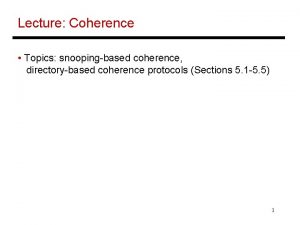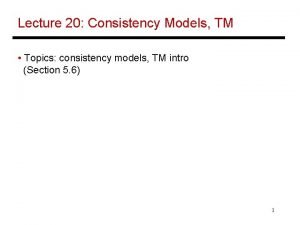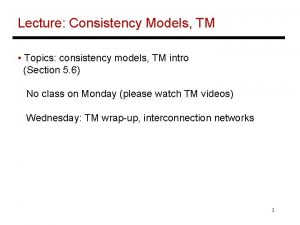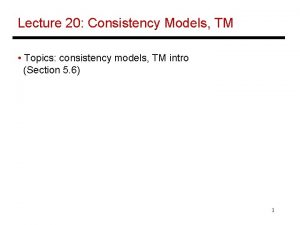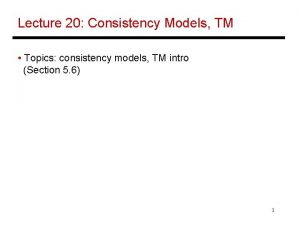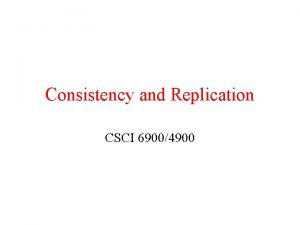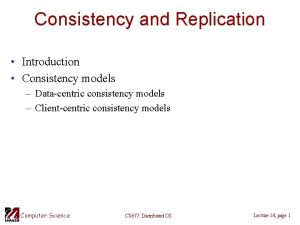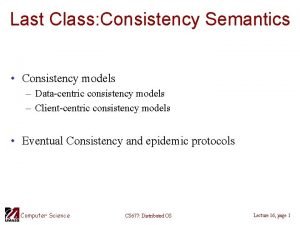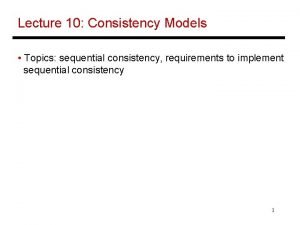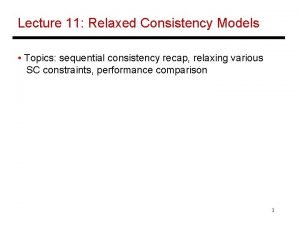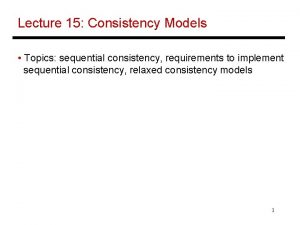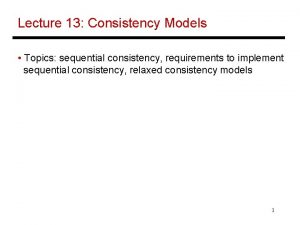Lecture 3 Coherence Protocols Topics consistency models coherence
















- Slides: 16

Lecture 3: Coherence Protocols • Topics: consistency models, coherence protocol examples 1

Sequential Consistency • A multiprocessor is sequentially consistent if the result of the execution is achievable by maintaining program order within a processor and interleaving accesses by different processors in an arbitrary fashion • For example, the code below should ensure mutual exclusion on a sequentially consistent machine Initially A = B = 0 P 1 P 2 A 1 B 1 … … if (B == 0) if (A == 0) Crit. Section 2

Relaxing Memory Ordering Initially A = B = 0 P 1 P 2 A 1 B 1 … … if (B == 0) if (A == 0) Crit. Section • Executing memory accesses in order is extremely slow; we attempt optimizations seq consistency is lost • For example, each processor can be out-of-order; within P 1, the write to A and the read of B are independent since they refer to different memory locations • Ooo execution will allow each process to enter CS 3

Relaxed Consistency Models • In order to write correct programs, the programmer must understand that memory accesses do not always happen in order • The consistency model specifies how memory ordering differs from that of sequential consistency • If the programmer demands sequential consistency in places, he/she can impose it with special fence instructions – a fence ensures that we make progress only after completing earlier memory accesses • Fences are slow – a better understanding of the program and the consistency model can eliminate some fences 4

Cache Coherence A multiprocessor system is cache coherent if • a value written by a processor is eventually visible to reads by other processors – write propagation • two writes to the same location by two processors are seen in the same order by all processors – write serialization 5

Cache Coherence Protocols • Directory-based: A single location (directory) keeps track of the sharing status of a block of memory • Snooping: Every cache block is accompanied by the sharing status of that block – all cache controllers monitor the shared bus so they can update the sharing status of the block, if necessary Ø Write-invalidate: a processor gains exclusive access of a block before writing by invalidating all other copies Ø Write-update: when a processor writes, it updates other shared copies of that block 6

Protocol-I MSI • 3 -state write-back invalidation bus-based snooping protocol • Each block can be in one of three states – invalid, shared, modified (exclusive) • A processor must acquire the block in exclusive state in order to write to it – this is done by placing an exclusive read request on the bus – every other cached copy is invalidated • When some other processor tries to read an exclusive block, the block is demoted to shared 7

Design Issues, Optimizations • When does memory get updated? Ø demotion from modified to shared? Ø move from modified in one cache to modified in another? • Who responds with data? – memory or a cache that has the block in exclusive state – does it help if sharers respond? • We can assume that bus, memory, and cache state transactions are atomic – if not, we will need more states • A transition from shared to modified only requires an upgrade request and no transfer of data • Is the protocol simpler for a write-through cache? 8

4 -State Protocol • Multiprocessors execute many single-threaded programs • A read followed by a write will generate bus transactions to acquire the block in exclusive state even though there are no sharers • Note that we can optimize protocols by adding more states – increases design/verification complexity 9

MESI Protocol • The new state is exclusive-clean – the cache can service read requests and no other cache has the same block • When the processor attempts a write, the block is upgraded to exclusive-modified without generating a bus transaction • When a processor makes a read request, it must detect if it has the only cached copy – the interconnect must include an additional signal that is asserted by each cache if it has a valid copy of the block 10

Design Issues • When caches evict blocks, they do not inform other caches – it is possible to have a block in shared state even though it is an exclusive-clean copy • Cache-to-cache sharing: SRAM vs. DRAM latencies, contention in remote caches, protocol complexities (memory has to wait, which cache responds), can be especially useful in distributed memory systems • The protocol can be improved by adding a fifth state (owner – MOESI) – the owner services reads (instead of memory) 11

Update Protocol (Dragon) • 4 -state write-back update protocol, first used in the Dragon multiprocessor (1984) • Write-back update is not the same as write-through – on a write, only caches are updated, not memory • Goal: writes may usually not be on the critical path, but subsequent reads may be 12

4 States • No invalid state • Modified and Exclusive-clean as before: used when there is a sole cached copy • Shared-clean: potentially multiple caches have this block and main memory may or may not be up-to-date • Shared-modified: potentially multiple caches have this block, main memory is not up-to-date, and this cache must update memory – only one block can be in Sm state • In reality, one state would have sufficed – more states to reduce traffic 13

Design Issues • If the update is also sent to main memory, the Sm state can be eliminated • If all caches are informed when a block is evicted, the block can be moved from shared to M or E – this can help save future bus transactions • Having an extra wire to determine exclusivity seems like a worthy trade-off in update systems 14

Examples MSI • P 1: Rd • P 1: Wr • P 2: Rd • P 2: Wr P 1 MESI Dragon MSI P 2 MESI Dragon X X X X Total transfers: 15

Title • Bullet 16
 Distributed data store
Distributed data store Eventual consistency vs strong consistency
Eventual consistency vs strong consistency Cache coherence protocols
Cache coherence protocols Distributed data store
Distributed data store Distributed shared memory architecture tutorialspoint
Distributed shared memory architecture tutorialspoint Monotonic reads
Monotonic reads Intel processor
Intel processor 01:640:244 lecture notes - lecture 15: plat, idah, farad
01:640:244 lecture notes - lecture 15: plat, idah, farad Modals and semimodals
Modals and semimodals Data link layer protocols for noisy and noiseless channels
Data link layer protocols for noisy and noiseless channels Ssl vpn wiki
Ssl vpn wiki Data wise protocols
Data wise protocols Cryptography standards and protocols
Cryptography standards and protocols Asynchronous rpc
Asynchronous rpc Message oriented middleware
Message oriented middleware Lan standards and protocols
Lan standards and protocols Saems protocols
Saems protocols
